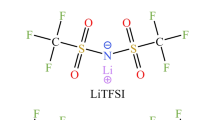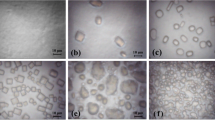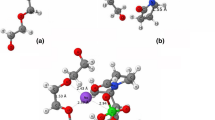Abstract
In this study, we investigated polymer chain dimensions in solid polymer electrolytes (SPEs) composed of hydrogenated and deuterated poly(ethylene carbonate/ethylene oxide) (h-/d-P(EC/EO)) copolymers and lithium bis(trifluoromethane)sulfonimide (LiTFSI) at various lithium-ion concentrations. The results were compared with h/d-poly(ethylene oxide) (PEO)/LiTFSI systems, extensively studied for their ionic conduction properties. The scattering intensity I(q) at low scattering vector q (≤ 0.4 Å−1) decreased with increasing lithium-ion concentration. From the low q data, the radius of gyration Rg of the polymer chains in SPE was estimated by the Guinier method. For both PEO and P(EC/EO) systems, with increasing the lithium-ion concentration (i.e., molar ratio of lithium ion to monomer, rs), Rg(rs) first decreased and then increased. Furthermore, the normalized Rg(rs) by Rg(0) exhibited a minimum at rs ≈ 0.15 for the PEO systems, whereas the P(EC/EO) system displayed a decrease in Rg to a higher rs (≈ 0.20) followed by a weak re-increase. Previous MD simulations (Y. Doi, et al., J. Phys. Chem. C2022, 126, 20,284) in the P(EC/EO)/LiTFSI systems have reported preferential coordination of carbonyl oxygens to lithium ions and an increase in the coordination number of oxygen atoms (resulting in the disrupted coordination structure) compared to the corresponding PEO systems, which can well explain the results in this study. The above experimental facts in this study are important findings in that they include data on new polymer systems other than PEO, while the number of reports for polymer conformation studies of SPE systems by SANS is still limited.
Graphical abstract





Similar content being viewed by others
Data availability
No datasets were generated or analysed during the current study.
References
Fenton D, Parker J, Wright PV (1973) Complexes of alkali metal ions with poly(ethylene oxide). Polymer 14:589
Wright PV (1975) Electrical conductivity in ionic complexes of poly(ethylene oxide). Br Polym J 7:319–327
Armand MB, Chabagno JM, Duclot Min (1979) In: Vashishta P, Mundy JN, Shenoy GK (eds) Fast ion transport in solids. North Holland, Amsterdam, pp 131–136
Armand M (1983) Polymer solid electrolytes – an overview. Solid State Ion 9–10:745–754
Müller-Plathe A, van Gunsteren F (1995) Computer simulation of a polymer electrolyte: lithium iodide in amorphous poly(ethylene oxide). J Chem Phys 103:4745–4756
Gadjourova Z, Andreev YG, Tunstall DP, Bruce PG (2001) Ion conductivity in crystalline polymer electrolytes. Nature 412:520–523
Borodin O, Smith GD (2006) Mechanism of ion transport in amorphous poly(ethylene oxide)/LiTFSI from molecular dynamics simulation. Macromolecules 39:1620–1629
Devaux D, Bouchet R, Gle D, Denoyel R (2012) Mechanism of ion transport in PEO/LiTFSI complexes: effect of temperature, molecular weight and end group. Solid State Ion 227:119–127
Do C, Lunkenheimer P, Diddens D, Götz M, Weiβ M, Loidl A, Sun X-G, Allgaier J, Ohl M (2013) Li+ transport in poly(ethylene oxide) based electrolytes: neutron scattering, dielectric spectroscopy, and molecular dynamics simulations. Phys Rev Lett 111:018301
Timachova K, Watanabe H, Balsara NP (2015) Effect of molecular weight and salt concentration on ion transport and the transference number in polymer electrolytes. Macromolecules 48:7882–7888
Marzantowicz M, Dygas JR, Krok F, Nowiński JL, Tomaszewska A, Florjańczyk Z, Zygadło-Monikowska E (2006) Crystalline phases, morphology and conductivity of PEO:LiTFSI electrolytes in the eutectic region. J Power Sources 159:420–430
Mindemark J, Lacey MJ, Bowden T, Brandell D (2018) Beyond PEO – alternative host materials for Li+-conducting solid polymer electrolytes. Prog Polym Sci 81:114–143
Kimura K, Yajima M, Tominaga YA, Highly-Concentrated (2016) Highly-concentrated poly(ethylene carbonate)-based electrolyte for all-solid-state Li battery working at room temperature. Electrochem Commun 66:46–48
Tominaga Y (2017) Ion-conductive polymer electrolytes based on poly(ethylene carbonate) and its derivatives. Polym J 49:291–299
Tominaga Y, Morioka T, Nakano K (2019) Random copolymers of ethylene carbonate and ethylene oxide for Li-Ion conductive solid electrolytes. Electrochim Acta 312:342–348
Doi Y, Allgaier J, Zorn R, Förster S, Egami T, Ohl M (2022) Relaxation dynamics and ion conduction of poly(ethylene carbonate/ethylene oxide) copolymer-based electrolytes. J Phys Chem C 126:20284–20292
Annis BK, Kim M-H, Wignall GD, Borodin O, Smith GD (2000) A study of the influence of LiI on the chain conformations of poly(ethylene oxide) in the melt by small-angle neutron scattering and molecular dynamics simulations. Macromolecules 33:7544–7548
Triolo A, Lo Celso F, Arrighi V, Strunz P, Lechner RE, Mastragostino M, Passerini S, Annis BK, Triolo R (2002) Structural and dynamical characterization of melt PEO–salt mixtures. Phys A 304:308–313
Loo WS, Mongcopa KI, Gribble DA, Faraone AA, Balsara NP (2019) Investigating the effect of added salt on the chain dimensions of poly(ethylene oxide) through small-angle neutron scattering. Macromolecules 52:8724–8732
**e S, Zhang B, Mao Y, He L, Hong K, Bates FS, Lodge TP (2020) Influence of added salt on chain conformations in poly(ethylene oxide) melts: SANS analysis with complications. Macromolecules 53:7141–7149
Fang C, Loo WS, Wang R (2021) Salt activity coefficient and chain statistics in poly(ethylene oxide)-based electrolytes. Macromolecules 54:2873–2881
Doi Y, Allgaier R, Förster S, Czakkel O, Egami T, Ohl M (in preparation) Neutron Spin Echo Study for correlation of normal mode dynamics and ion conductivity for poly(ethylene carbonate/ethylene oxide) copolymer-based electrolytes
Takata S, Suzuki J, Shinohara T, Oku T, Tominaga T, Ohishi K, Iwase H, Nakatani T, Inamura Y, Ito T, Suzuya K, Aizawa K, Arai M, Otomo T, Sugiyama M (2014) The design and q resolution of the small and wide angle neutron scattering instrument (TAIKAN) in J-PARC. JPS Conf. Proc 8:1–6
Guinier A, Fournet G (1955) Small angle scattering of X-rays. Wiley, New York
Acknowledgements
SANS measurements at J-PARC were carried out with Proposal No. 2020A0040, 2020B0009, and 2022B0055 at BL-15, and the authors thank Dr. Hiroki Iwase (CROSS) for his technical support.
Funding
This study is partly supported by the Ogasawara Toshiaki Memorial Foundation, Yazaki Memorial Foundation for Science and Technology, ENEOS Tonen General Research/Development Encouragement & Scholarship Foundation, the Naito Science & Engineering Foundation, Toyoaki Scholarship Foundation, Amano Institute of Technology, Iwatani Naoji Foundation and Research Foundation for the Electrotechnology of Chubu, and the first author (Y.D.) acknowledges them.
Author information
Authors and Affiliations
Contributions
All authors contributed to the conceptualization of this study. Y.D. synthesized and characterized the samples, performed SANS measurements, analyzed the SANS data, and written the original manuscript. J.A. synthesized and characterized the samples. S.F. has supervised. S.T. was the local contact during the SANS beam time and gave suggestions for the SANS data treatment. M.O. has supervised, discussed the data, and revised the manuscript. All authors read and approved the manuscript.
Corresponding authors
Ethics declarations
Ethics approval
Not applicable.
Competing interests
The authors declare no competing interests.
Additional information
Special issue dedicated to the occasion of the 60th birthday of Stephan Förster.
Publisher’s Note
Springer Nature remains neutral with regard to jurisdictional claims in published maps and institutional affiliations.
Appendices
Appendix 1. Treatment of incoherent scattering
As described in experimental, the main component of incoherent scattering in the raw SANS profile was assumed to be from the protonated polymer in the sample. Thus, the coherent scattering intensity, Icoh(q), shown in the main text is estimated by subtracting the incoherent contribution (Iincoh(q) = Φh-polymIh-polym(q), where Φh-polym denotes the volume fraction of hydrogenated polymer in the sample) from the raw data, Iraw(q). Figure 5 shows the scattering profiles before and after subtracting the incoherent scattering for h/d-P(EC/EO)/LiTFSI samples with different wLi (= 0 and 0.33). In the high q region, LiTFSI in addition to the hydrogenated polymers may work as an incoherent component, but at least in the low q (≤ 0.1 Å−1) region discussed in the main text, our incoherent scattering treatment has little effect on the main conclusion of this study.
Appendix 2. Volume fraction dependence of I(0)
In Figs. 2a and 3a in the text, we have applied the Guinier approximation to obtain I(0) as well as Rg for the PEO/LiTFSI and P(EC/EO)/LiTFSI systems for different wLi. In principle, I(0)s obtained there should reflect the molecular weight and fraction of polymers as scatterers. Figure 6 shows the dependence of I(0) on the polymer volume fraction ΦP for PEO/LiTFSI and P(EC/EO)/LiTFSI. In Fig. 6, a good proportional relationship with zero intercept is obtained for both PEO/LiTFSI and P(EC/EO)/LiTFSI, although there is some variance in the data. At the same ΦP, I(0) is higher for the P(EC/EO) system than for the PEO one, mainly because the former has a higher molecular weight, which is correlated with scattering ability.
Rights and permissions
Springer Nature or its licensor (e.g. a society or other partner) holds exclusive rights to this article under a publishing agreement with the author(s) or other rightsholder(s); author self-archiving of the accepted manuscript version of this article is solely governed by the terms of such publishing agreement and applicable law.
About this article
Cite this article
Doi, Y., Allgaier, J., Förster, S. et al. Chain dimensions of poly(ethylene carbonate/ethylene oxide) copolymer with salt addition studied by SANS. Colloid Polym Sci (2024). https://doi.org/10.1007/s00396-024-05279-2
Received:
Revised:
Accepted:
Published:
DOI: https://doi.org/10.1007/s00396-024-05279-2






